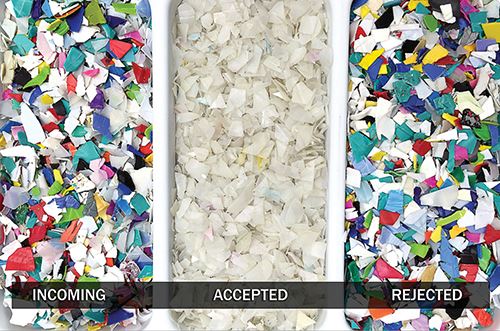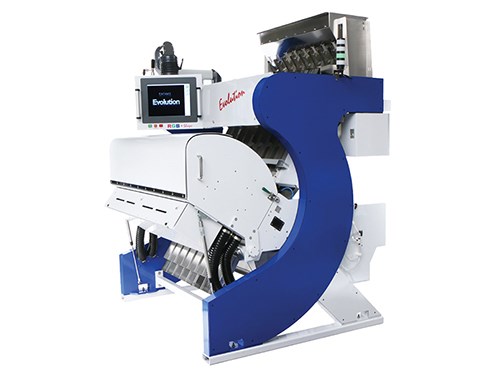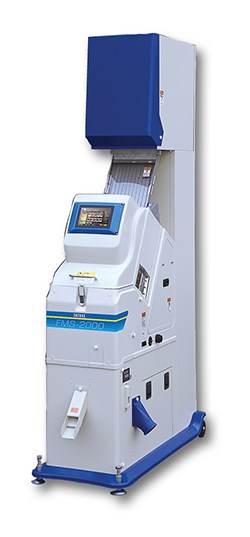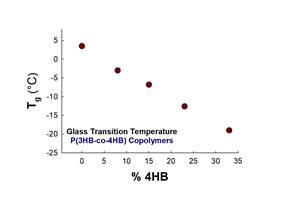How Optical Sorting Can Boost Your Reclaim Operation
Here are tips on how to implement optical-sorting technology to increase the value of regrind and flake produced in your plant.
Optical “color” sorters date back to the 1930s and were used initally to improve quality and safety of food products. Growth in PET recycling paved the way for their use in plastics—first to remove green and other colors from clear PET in beverage containers, then to remove PVC and other polymers that may be the same color as the clear PET, but exhibit different melt temperatures.
As optical sorting became commonplace for PET, other sectors of the industry started realizing the potential of separating regrind by color. One of the early adoptees was the PVC window regrind market, as they generated a lot of potentially high-value regrind that had rubber attached to it. This material tended to be light in color with black rubber attached, making it an ideal application for color sorting.
PROBLEMS AND SOLUTIONS
While several sectors of the industry had ideal applications for color-sorting equipment, the vast majority of processors and regrind handlers had a number of hurdles to overcome before being able to realize the significant benefits that this technology could offer. A couple of the more common hurdles were:
• Complexity: While single-color streams with great contrast were relatively easy, most regrind-sorting opportunities needed to handle a variety of ever-changing colors. Until recently, color sorters relied on various optical filters, colored lamps, and color-matched backgrounds to achieve specific color sorts. These sorters could do an excellent job, but were too difficult and too time consuming to optimize for the wide variety of sorts encountered by most processors and reclaimers. In addition, the learning curve was high and frequent employee turnover created an environment that kept most companies from realizing the benefits of optical sorting.
• Cost and Capacity: Existing technologies designed to handle the high capacity demands of the food industry tended to be too large and expensive for most plastics regrind applications. Regrind applications often required multiple sorts to achieve the desired finished product and the changeover took too much time, adding additional cost.
Now, though, optical sorting is a viable option for any processors or recyclers that generate moderate to high volumes of regrind and would like to reintroduce it into their own feedstock or sell it on the market at premium prices. The driving force that has opened this technology to the industry at large is the introduction of compact, user-friendly, full-color, camera-based sorting machines.
With minimal operator training, these machines can easily be programmed to recognize targeted colors; and once set, the sort parameters can be stored for easy retrieval when more of the same regrind is generated. The use of closely bundled, high-speed air ejectors, modular design, and manufacturing efficiencies have greatly reduced the footprint and initial capital investment required.
IMPLEMENTATION STRATEGIES
For an optical sorter to function properly, several criteria must be met. The product to be sorted must be accelerated, singulated, passed through a viewing chamber to be scanned by the cameras and analyzed, and then the undesired colors must be ejected.
The first step in achieving the above criteria is to get the product to be sorted into relatively uniform size particles. This can be achieved with proper screening, aspiration, or a combination of the two. This step is important, as fine dust and very small particles can obscure the viewing area and decrease the sorting efficiency. Another issue with trying to sort a wide range of mixed particle sizes is that a very small color defect next to a large good particle would likely result in both being rejected, which would hurt overall efficiency.
The machines can be installed in-line with the process or in an area off-line where batches can be run as required. One advantage of the batch concept is that the same machine can handle mixed-color regrind from multiple lines. In either case, the machine should be installed in an area with minimal vibration, protected from potential forklift damage, where temperatures remain above freezing and below 115 F, and away from any water spray from the process or cleaning. If installed in a very hostile environment, the machine should be enclosed to isolate it from extreme heat, water, or other environmental factors.
The machine should be installed with ample room around it for routine maintenance and service when required. The machine can be fed with box dumpers, vacuum systems, pneumatic feeders, and other typical process machinery. These should be mounted in a manner that will not introduce vibration or damage to the sorting machine’s infeed hopper.
Optical sorters work best when supplied with a consistent feed rate, so a large enough surge hopper should be provided to minimize starting and stopping once a campaign has started.
The optical sorter should be supplied with clean, uniform power, and it is also important to have clean, dry air for the ejectors. This air requirement is usually met by utilizing an air compressor with a refrigerated dryer and proper filtration. While a dedicated compressor would be ideal, most plants utilize plant air, provided that it meets the air-quality requirements and is sized to provide a constant volume of air to the sorter regardless of how contaminated the infeed product.
OPERATION & MAINTENANCE BEST PRACTICES
Once properly installed, it is best to bring in factory-trained field-service engineers from the manufacturer to verify installation and train the operators and plant maintenance personnel. Once the operators are properly trained, the equipment is relatively easy to maintain.
After determining the proper settings to obtain the desired sort, the operator mainly needs to check periodically to make sure that the machine is staying clean and maintaining the required quality.
Most machines incorporate an automatic wiper and or air blowdown system to keep the viewer clean; but in extremely dusty environments, additional attention from the operator may be required. As a matter of habit, most plants have the unit cleaned prior to each shift or before each new large batch run. This takes a short time and ensures that the machine continues to run at peak efficiency.
A properly installed and maintained optical sorter can generally achieve a very fast return on investment and many years of relatively low-cost, low-maintenance service. While it took many years for the technology to evolve to this point, optical sorting is now within the reach of anyone that generates low to moderate levels of mixed-color regrind and desires to salvage specific colors.
Related Content
‘Monomaterial’ Trend in Packaging and Beyond Will Only Thrive
In terms of sustainability measures, monomaterial structures are already making good headway and will evolve even further.
Read MoreFilm Extrusion: Boost Mechanical Properties and Rate of Composting by Blending Amorphous PHA into PLA
A unique amorphous PHA has been shown to enhance the mechanical performance and accelerate the biodegradation of other compostable polymers PLA in blown film.
Read MorePregis Performance Flexibles: In the ‘Wow’ Business
Pregis went big and bold with investment in a brand-new, state-of-the-art plant and spent big on expanding an existing facility. High-tech lines, well-known leadership and a commitment to sustainability are bringing the “wow” factor to blown film.
Read MoreCompatibilizers Aid Recycling & Upcycling of Mixed Resins
Compatibilizers are proving their worth in boosting critical properties such as impact/stiffness balance of PCR and PIR blends of polyolefins and other plastics.
Read MoreRead Next
Why (and What) You Need to Dry
Other than polyolefins, almost every other polymer exhibits some level of polarity and therefore can absorb a certain amount of moisture from the atmosphere. Here’s a look at some of these materials, and what needs to be done to dry them.
Read MoreUnderstanding Melting in Single-Screw Extruders
You can better visualize the melting process by “flipping” the observation point so that the barrel appears to be turning clockwise around a stationary screw.
Read More









.png;maxWidth=300;quality=90)




















